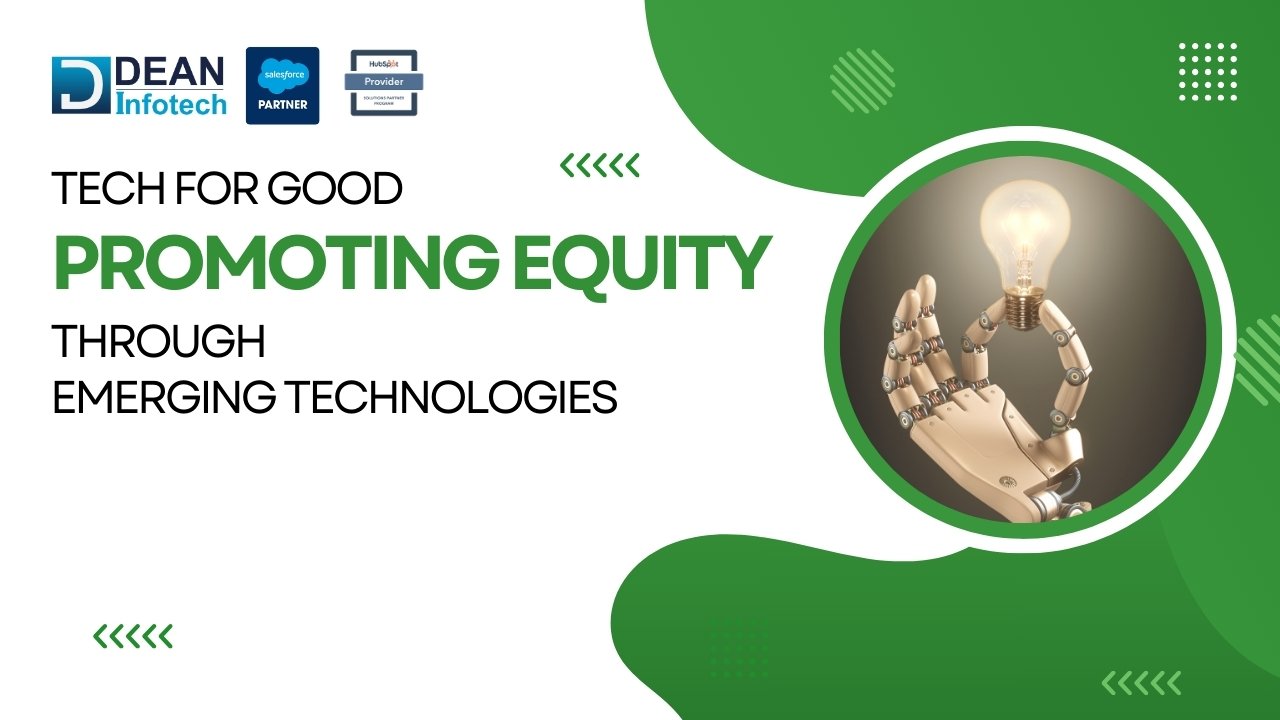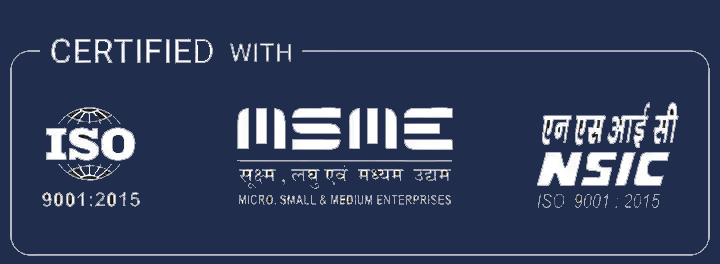Tech for Good — Promoting Equity Through Emerging Technologies
 Ankit Agarwal Monday, March 24, 2025
Ankit Agarwal Monday, March 24, 2025
In an increasingly digital world, technology holds the power to drive positive change and address some of society's most pressing challenges. From expanding access to education and healthcare to fostering financial inclusion, emerging technologies are opening new pathways for underserved communities. However, the true potential of technology can only be realized when it is designed and deployed equitably — ensuring that no one is left behind.
Tech for Good is a growing movement that champions the responsible use of innovation to bridge social, economic, and digital divides. By promoting equity through emerging technologies, businesses, governments, and organizations can create inclusive opportunities that empower marginalized communities. From artificial intelligence (AI) and blockchain to the Internet of Things (IoT) and virtual reality (VR), these advancements are reshaping industries while making a lasting impact on society.
In this blog, we will explore how emerging technologies are promoting equity, examine real-world examples of impactful initiatives, and discuss how businesses and policymakers can play a role in ensuring a fair and inclusive technological future.
Let’s dive in and discover how tech can truly be a force for good!
Understanding Equity in the Digital Age
Equity in the digital age means ensuring that everyone, regardless of their background, location, or circumstances, has fair access to technology and the opportunities it brings. Unlike equality, which provides the same resources to all, equity recognizes that different communities have different needs and requires the allocation of resources in a way that levels the playing field.
Why Digital Equity Matters
In today’s interconnected world, technology drives access to education, healthcare, financial services, and employment opportunities. However, millions of people, particularly in underserved and marginalized communities, lack access to these essential resources. The digital divide — the gap between those who have access to technology and those who do not — continues to widen, exacerbating existing social and economic inequalities.
Key factors contributing to digital inequity include:
- Limited Internet Access: Rural and low-income areas often face poor or no internet connectivity.
- Lack of Digital Literacy: Without proper training, many individuals struggle to navigate digital tools.
- Financial Barriers: The cost of devices, software, and broadband services remains inaccessible to many.
- Technology Bias and Exclusion: Algorithms and AI systems can reinforce systemic biases, disproportionately impacting marginalized communities.
Equity vs. Equality in Technology
To illustrate the difference, consider a scenario where a government distributes the same type of computers to all schools. While this may promote equality, it does not account for schools in underserved areas that may lack proper infrastructure or technical support. Equity, on the other hand, would ensure those schools receive additional resources, training, and infrastructure support to bridge the gap.
The Role of Technology in Promoting Equity
Emerging technologies are uniquely positioned to address these disparities by:
- Enhancing Access: Expanding affordable internet and mobile networks in remote areas.
- Empowering Education: Providing digital learning platforms tailored to students’ needs.
- Improving Healthcare: Enabling telemedicine services for rural and underserved regions.
- Promoting Financial Inclusion: Offering accessible digital banking and microfinance solutions.
By acknowledging and addressing systemic inequalities through equitable tech solutions, organizations and governments can foster a more inclusive digital economy — one where innovation benefits everyone, not just a privileged few.
Key Challenges in Achieving Equitable Access to Technology
While emerging technologies have the potential to drive positive change, achieving equitable access remains a significant challenge. Several barriers prevent marginalized communities from fully benefiting from digital advancements. Understanding these challenges is the first step toward creating inclusive and sustainable solutions.
1. Digital Divide
The most visible challenge is the digital divide — the gap between those with reliable access to technology and those without. This divide is often more pronounced in:
- Rural and Remote Areas: Lack of internet infrastructure and connectivity.
- Low-Income Communities: Limited access to affordable devices and internet services.
- Developing Countries: Insufficient investment in digital infrastructure.
2. Affordability and Economic Barriers
For many communities, the cost of technology remains prohibitive.
- High Cost of Devices: Smartphones, computers, and tablets are often expensive.
- Data and Connectivity Expenses: Internet services may be costly or unreliable.
- Limited Access to Financing: Many lack access to financial services for purchasing tech products.
3. Lack of Digital Literacy
Even when technology is available, digital literacy is essential for meaningful use.
- Insufficient Training Programs: Many communities lack access to digital skills training.
- Generational Gap: Older populations may struggle with adopting new technologies.
- Language Barriers: Digital platforms may not be available in local languages.
4. Bias in Technology
Emerging technologies, particularly AI and machine learning, often inherit biases from the data used to train them.
- Algorithmic Discrimination: AI systems may reinforce stereotypes or exclude marginalized groups.
- Lack of Representation: Underrepresentation in tech development leads to products that do not meet the needs of diverse users.
- Unconscious Bias: Developers may unintentionally create biased systems without diverse perspectives.
5. Infrastructure Limitations
Inadequate infrastructure remains a key barrier in many regions.
- Unreliable Power Supply: Many areas lack consistent electricity to power devices.
- Limited Broadband Access: Broadband infrastructure is underdeveloped in remote regions.
- Device Shortages: Lack of hardware distribution channels in underserved areas.
6. Policy and Regulatory Gaps
Without supportive policies, equitable access to technology is difficult to achieve.
- Lack of Digital Inclusion Policies: Governments may not prioritize digital equity in their agendas.
- Inadequate Funding: Limited investments in tech infrastructure and digital literacy programs.
- Data Privacy Concerns: Weak regulations can lead to exploitation of vulnerable populations.
Addressing the Challenges
To bridge these gaps, collaborative efforts are necessary. Governments, businesses, and nonprofits must:
- Invest in digital infrastructure development.
- Provide affordable connectivity solutions.
- Promote inclusive product design with diverse perspectives.
- Offer digital literacy programs in underserved communities.
- Implement policies that prioritize equitable access to technology.
By addressing these challenges, we can ensure that technology serves as a tool for empowerment rather than a source of further division. In the next section, we’ll explore how emerging technologies are already making strides in promoting equity across various sectors.
Importance of Inclusive Innovation and Ethical Tech Development
In today’s fast-paced digital landscape, innovation is often celebrated for its disruptive potential. However, true progress is measured not only by technological advancements but also by the positive impact it creates for all members of society. Inclusive innovation and ethical tech development are crucial to ensuring that emerging technologies benefit everyone, particularly marginalized and underserved communities.
What is Inclusive Innovation?
Inclusive innovation refers to the creation of technologies, products, and services that address the needs of diverse populations, including those historically excluded from the benefits of technological progress. It involves:
- Designing solutions with accessibility in mind.
- Prioritizing equitable outcomes for underserved communities.
- Collaborating with stakeholders from diverse backgrounds during the development process.
Why Inclusive Innovation Matters
- Bridging the Digital Divide: Inclusive innovation ensures that technological advancements reach communities with limited access to digital resources, empowering them with opportunities in education, healthcare, and financial services.
- Economic Empowerment: Providing inclusive access to technology opens up employment and entrepreneurship opportunities, particularly in underserved regions. It also encourages local innovation, driving economic growth.
- Social Impact and Improved Quality of Life: Technologies designed to address community-specific challenges can lead to tangible improvements in quality of life. For example, telemedicine platforms can provide healthcare access in rural areas, and mobile banking apps can serve unbanked populations.
- Promoting Diversity in the Tech Industry: A more inclusive approach fosters diverse perspectives, leading to the development of products that better serve the needs of a broader population. Diversity in tech teams also helps minimize unconscious biases in design and development.
What is Ethical Tech Development?
Ethical tech development involves creating technology responsibly, ensuring it is fair, transparent, and respectful of human rights. It considers the societal impact of innovations and prioritizes ethical decision-making throughout the product lifecycle.
Key principles of ethical tech development include:
- Fairness and Inclusion: Developing AI systems and algorithms that are free from bias.
- Transparency and Accountability: Providing clear explanations of how technologies work and holding developers accountable for their impacts.
- Data Privacy and Security: Safeguarding user data and protecting privacy.
- Sustainability: Ensuring that technological solutions minimize environmental impact.
The Role of Businesses and Organizations
Companies play a significant role in driving inclusive and ethical innovation. Here’s how they can contribute:
- Diverse Hiring Practices: Build inclusive development teams with diverse perspectives.
- Community Engagement: Collaborate with local communities to co-create solutions that address real-world challenges.
- Responsible AI Implementation: Regularly audit AI systems to detect and mitigate bias.
- Transparent Policies: Communicate how user data is collected, used, and protected.
Conclusion
Technology has the power to bridge gaps, break down barriers, and create opportunities — but only when it is designed and implemented with equity in mind. Emerging technologies like AI, blockchain, and IoT are already making significant strides in promoting fairness and inclusion across sectors such as healthcare, education, finance, and more. However, the path to a truly equitable digital future requires continuous effort and collaboration.
At Dean Infotech, we believe in harnessing the power of technology to drive positive change. Our commitment to inclusive innovation and ethical tech development ensures that the solutions we create empower businesses and communities alike. By delivering transformative digital experiences, we help organizations embrace emerging technologies responsibly while making a lasting impact.
As we continue to push the boundaries of innovation, we invite businesses, governments, and changemakers to join us in using tech for good. Together, we can shape a digital landscape where no one is left behind — creating a more just, inclusive, and equitable world for all.








Comment